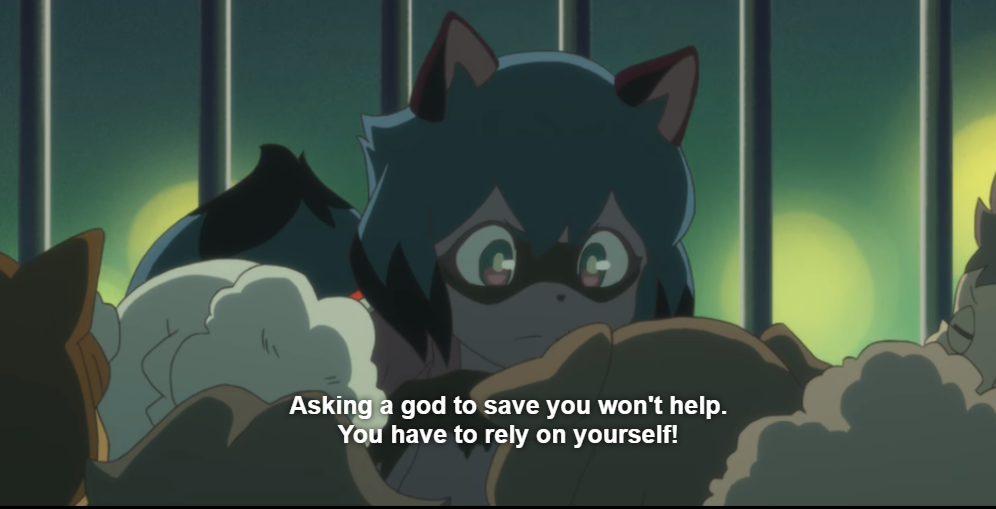Anime Review: BNA )Brand New Animal
Beastmen are an alternate evolutionary branch that have existed alongside homo sapiens since prehistory. They look exactly like humans in their primary form, but can morph into an anthropomorphic “beastman” form that gives them abilities of the animal they’re tied to. Relations between humans and beastmen have sometimes been good and sometimes bad, but usually bad, and since humanity has spread all over the globe so there’s no place to hide, the minority beastmen have suffered oppression. Beastmen are born that way and cannot interbreed with normal humans, so it’s a huge surprise for human schoolgirl Michiru Kagemori when she abruptly turns into a beastman one day.

Fortunately, there’s a place for beastmen to go, Anima-City, the first all-beastman city in a thousand years, established off the coast of Japan by an agreement with the Japanese government. It’s about to have its tenth anniversary. Unable to stand hiding in her room anymore, and thinking that the people of Anima-City might know something about her “beastman disease”, Michiru runs away from home.
Since there’s only one route to Anima-City, anti-beastman bigots have set up camp to hunt and kill refugees heading towards the area. Michiru’s saved from them by smuggler Marie the Mink, but at a high cost, and arrives just in time for Anima-City’s tenth anniversary celebration.
Anima-City isn’t exactly as Michiru had pictured it. For starters, beastmen tend to stay in their human-looking forms unless their emotions are running high. Due to their oppression, many beastmen had little choice but to become criminals in the outside world, and when they came to the city didn’t have any other job skills. A large percentage of the population is illiterate, and there’s a slum area of grinding poverty. Organized crime is a serious issue, as is petty crime, and at the festival, there is even a terrorist bombing!
Since she witnessed one of the terrorists setting the bomb, Michiru gets involved in tracking them down, as does social worker/government consultant Shirou Ogami, a wolf beastman. Shirou is about ready to kill the terrorists when he discovers they were hired by humans to do the deed, but Michiru manages to talk him down and he only uses his superior combat skills to beat them up very badly so they won’t escape before the police come.
Shirou is initially disbelieving of Michiru’s claim of being born human, and hostile once she proves it, but Anima-City mayor Barbara Rose (the first beastman ever to earn a doctorate!) agrees to help Michiru solve the mystery of her transformation. Michiru and Shirou face various crises before the true story is revealed.
This 2020 Trigger Studios anime is now available on Netflix. In some places, like the baseball episode, it’s really obvious that it’s a Trigger production with the zany scenario and over the top wackiness.
Good: Excellent animation, fun character designs, decent music. I like the Batman and Robin style relationship between our protagonists.
The themes are pretty deep here, starting with the racism allegory. Of course there’s the standard obvious bigots. but Michiru isn’t immune. She’s a good kid who treats any individual beastman she meets as an equal and possibly friend, but she’s still absorbed her culture’s prejudice against beastmen as a group. She sees beastmen as other, and refers to her transformation as a “disease” right in front of people who’ve lived all their lives being oppressed for being beastmen. She has to learn some hard lessons about her attitudes.
Shirou, conversely, has to open up to the possibility that at least some humans are not evil and untrustworthy, despite his long experience otherwise.
There’s some interesting religious stuff too. Michiru isn’t a believer, so she initially sees the Silver Wolf folk religion as a silly if harmless superstition. But then it suddenly turns into a cult, with an actual Silver Wolf figure that has a familiar face. Michiru has to balance knowing that’s not the “real” Silver Wolf with the good that the religion seems to be doing.
And then there’s the theme of learning to live with change. Michiru’s initially stuck in her tanuki form, and even finally getting unstuck isn’t fully satisfying; and Shirou also has to learn to accept that change has occurred and will keep happening.
Less good: Some plot twists are a little too telegraphed: Sylvasta Pharmaceuticals was obviously shady from the moment it was first mentioned. A major one in the final episode, on the other hand, comes out of seeming nowhere.
The short length of the season causes some of the plot points to become too cramped together; another couple of episodes might have helped.
Content note: Fantastic racism, terrorism, genocide, human beastman trafficking, vivisection, some intense violence. The Nina episode would be especially fruitful for parents to talk to their kids about fetishizing other cultures without actually making an effort to understand them. Junior high on up, with some caution.
Overall, a fun show with nifty visuals but enough depth to be worth thinking about.

